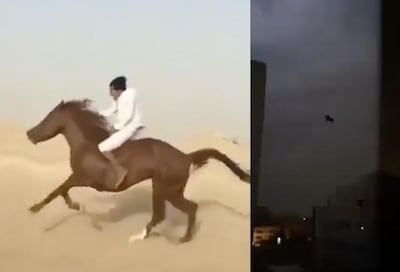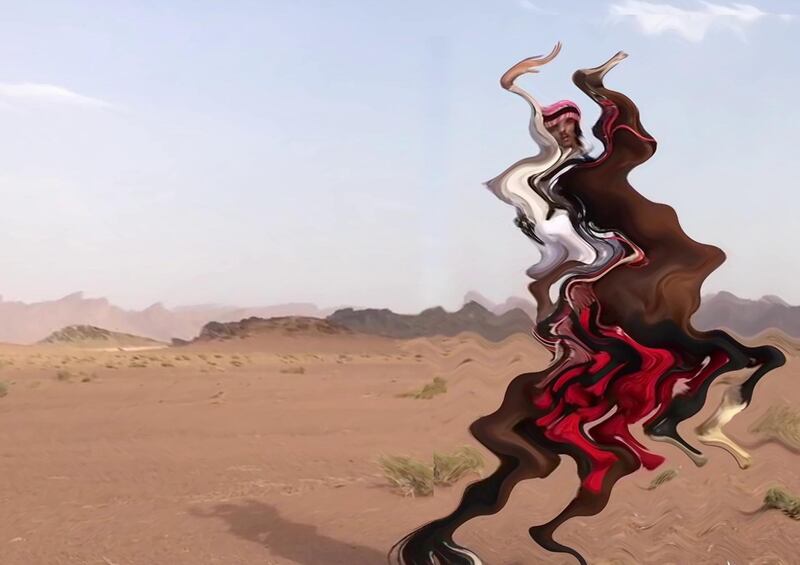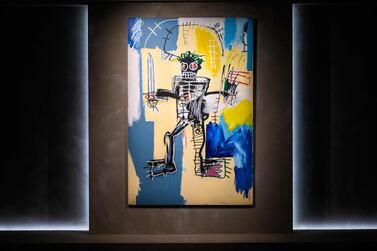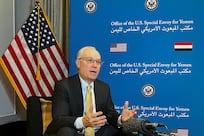A new wave of NFT art from the Gulf is set to enter the virtual realm as more artists and gallerists from the region join in on what seems to be a crypto art gold-rush.
NFT art, or digital art that is tokenised on the blockchain and purchased using cryptocurrency, made headlines in March following a Christie's auction where a digital artwork by artist Beeple sold for a staggering $69.4 million.
It wasn't just the price tag that caught the world's attention, but the technology through which the artwork was sold, too. NFTs, which stands for non-fungible tokens, are digital certificates that authenticate ownership of certain digital assets – videos, music, drawings, or even tweets, memes and articles – through blockchain technology.
In the region, a number of people, including Bandar Al-Wazzan, founder of Gallery Bawa, a digital art gallery in Kuwait, have seen an opportunity to be a pioneer for dealing crypto art.
On Thursday, Bawa launched its latest exhibition titled Suadi Old Man Calling The Camels In The Desert and they run to him like baby run to his mother, then they start Kissing and huging him [sic], a solo show with Saudi artist Ahaad Alamoudi and also the first NFT art exhibition presented by a gallery in the Gulf.
It features six works by Alamoudi, including video compositions of footage found on the internet that humorously reflect upon the kingdom's changing identity.
"Initially, I thought that I would never be a part of that industry," Alamoudi says about entering the NFT space. "Having said that, I believe knowledge is empowering and I'm interested in what this system means for the future of the art world."
Al-Wazzan set up Bawa as an online gallery six months ago with the desire to spotlight Khaleeji artists. The show with Alamoudi had been in the works for months, with the artist and Al-Wazzan expecting to sell prints of the videos via the gallery website. But the Christie's sale changed everything, and Al-Wazzan quickly reconceived the exhibition, "minting" (a term for creating something on the blockchain) the artist's videos and stills into NFTs.

These videos and stills are currently priced in the range of 0.8 to 0.9 Ether, or $1,870 to $2,100 at the time of writing. Collectors can purchase the works on OpenSea, an online marketplace for NFTs that requires users to possess a digital wallet, where their cryptocurrency is stored. Often, NFTs are sold using Ether, a cryptocurrency built on the Ethereum blockchain.
For Al-Wazzan, NFT technology offers a huge opportunity for digital artists, because it allows for the existence of an original in a virtual world filled with copies. So while artworks that come in the format of jpegs, gifs and video clips can be downloaded and duplicated, the possessor of the certificate still maintains his or her ownership of the asset.
"It's going to change the art market in the next 10 years," Al-Wazzan says. "Anyone can enjoy and download the NFT, but only one person can own it. And that's a human thing in the end. You can own a replica of the Mona Lisa and hang it on your wall, but you will always know that the original hangs in the Louvre. That's the same for NFTs as well."
Other gallerists, such as Sunny Rahbar, founder of The Third Line in Dubai, says it is important to look past the current buzz around NFTs to see if its revolutionary promises are valid.
"I've started to really educate myself on it," she says. "These prices are perhaps what is baffling people … I realise that right now it's kind of like the Wild West, but I do think this technology is very useful for our industry, especially when it comes to provenance and for these contracts where artists continue to get paid in the resale of their work, which doesn't happen in the traditional art world."
Rahbar is referring to one of NFTs’ greatest advantages over traditional art deals – the ability for artists to make money on the secondary market. Typically, when an artwork is bought from a gallery by a collector, he or she can resell the piece privately or at auction for a higher price, without the artist sharing in the profit. With NFTs, however, artists continue to earn a percentage of profit for every resale, and because the NFT is tied to the blockchain, every transaction is logged.
This feature is what drew artist Alamoudi to agree to Bawa's NFT show. "The main benefit is that it puts the artist first, having control over how the works are distributed with an element of transparency is ideally the future of the art industry," she says.
NFTs can also be created for physical artworks, proposes Rahbar, so that all future sales can be recorded. “This is a way of safekeeping artworks,” she says. “It can be a beautiful relationship between the digital realm and the physical one.”
One of the gallery's represented artists, Amir H Fallah, minted his own NFT titled Immortal independently in March. The Tehran-born artist, who lives in California, typically creates paintings and installations, but his venture into NFT shows that more traditional forms of art can adapt to the digital sphere, too.
Even pre-Beeple, artists in the Gulf have sold their NFTs on online marketplaces. Amrita Sethi, a banker-turned-artist, for example, minted her artwork with platform Terra Virtua in October 2020, corresponding with the opening of World Art Dubai last year.
Sethi’s knowledge in finance helped her get in on the game early. She says that the excitement around NFTs will normalise, and the process of collecting the digital works will mirror the way it is done in the physical world, with collectors following the trajectory of creators they like.
Still, some artists and galleries remain wary of the rapid rise of NFT art. For Rahbar, she is willing to explore its potential, especially since the pandemic pushed much of the art world to embrace virtual shows. "I really think with social media and online programming we have already been on this path, and artists are doing this for themselves anyway," she says. Tapping into the crypto art collector network could bring more revenue for artists, she points out.
Currently, The Third Line is in the process of working on NFTs with its roster of artists and participating in collectives for digital shows in the UAE.
Joel Dietz, a crypto entrepreneur who recently moved to Dubai to set up NFT art initiatives, says he wants sceptics to focus on the communities involved in NFTs, rather than just the technology. “Get to know the people who are doing it, not just as a gif or jpeg on the internet... Obviously there’s a lot of speculation involved, but the actual energy and personality of the people behind it are what draws me back.”
Among the biggest concerns with NFTs, and cryptocurrency in general, is its impact on the environment. Since it was established, the Ethereum blockchain has resulted in 96,200,000 tonnes of carbon dioxide, according to ArtNews. The percentage of which NFTs, and specifically NFT art, is responsible and will be responsible for these emissions is not clear.
Editor's note: A previous version of this article incorrectly identified Joel Dietz as the founder of MetaMask and on the founding team of Ethereum. This has been corrected.







